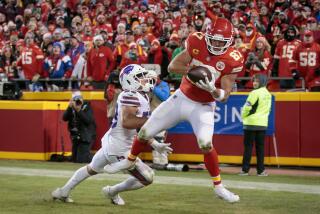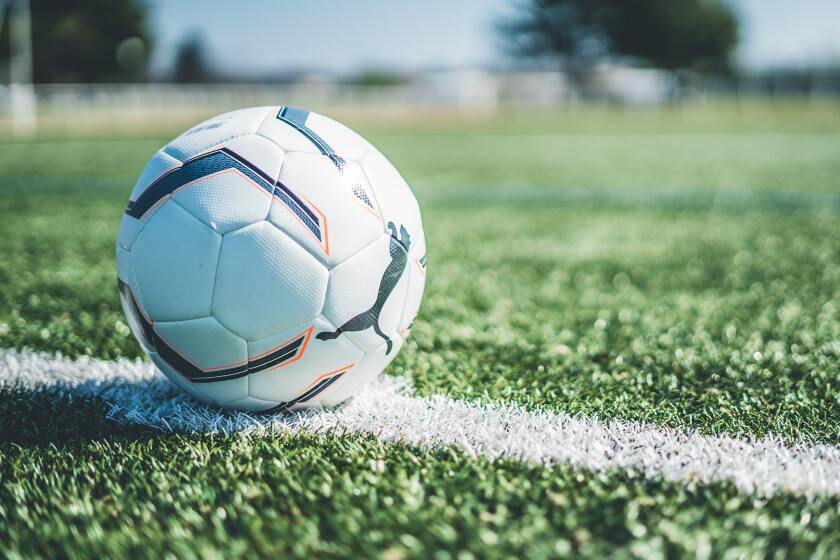Vicious Tacklers Will Take Big Hit From NFL Officials
- Share via
It’s late in the afternoon practice Friday and San Diego quarterback Drew Brees throws a slant pass to rookie receiver Kassim Osgood. But just as the pass reaches Osgood’s hands, defensive back Drayton Florence charges into the play and lunges at his teammate.
According to referee Terry McAulay, if Florence leaves his feet to make the same type of play during the regular season, he will pick up a 15-yard personal foul penalty because the NFL has done a better job of defining what is an illegal hit and what’s not.
“It doesn’t even have to be a helmet-to-helmet hit,” said McAulay at the Chargers’ training camp at the Home Depot Center in Carson.
“Launching with a shoulder would be a foul too. The key is, you can’t launch at anyone that is defenseless, usually meaning receivers and quarterbacks. When you jump in the air and launch yourself into a hit, that’s a foul.”
Violent big hits may be a key reason behind the NFL’s popularity, but that’s not stopping the league from from clamping down even more on dangerous hits that could lead to injuries. But it’s a fine line in determining when a player is defenseless.
“If you have two feet on the ground with the ball, then you’re a runner and you’re not defenseless,” McAulay said. “The league just wants to protect its players....You can still punish a receiver legally. No lowering of the helmet, just hitting hard.”
Last season, the NFL seemed to crack down on vicious hits more than ever. Denver’s Kenoy Kennedy and San Diego’s Rodney Harrison each were suspended for helmet-to-helmet hits and Dallas’ Darren Woodson and Philadelphia’s Brian Dawkins each picked up sizable fines for helmet-to-helmet hits that didn’t involve suspensions.
San Diego veteran defensive back Ryan McNeil, in his 11th season, said he’s glad that the league has provided a better definition on illegal hits.
“It’s for the safety of the game,” said McNeil, who was involved with the NFL Players Assn.’s competition committee that met with league officials during the off-season. “One thing that we wanted to get defined was those illegal hits. That’s what we were able to accomplish and I’m all for that.
“The good thing is that by having officials here now going over the rules, we’ll have a good understanding once the season starts.... I don’t have a problem playing within the rules and the rules they are enforcing are already in place.”
Although the NFL did not install any major rule changes, the league has either revised or defined several minor ones, including leg whips and any type of hit to the helmets of quarterbacks.
“Officials don’t try and determine the intent,” McAulay said. “We try and judge the act itself. We’re taught that the players are professionals and that there’s very little that they are not trying to do. They know what they are doing in nearly every case.”
The biggest change with officials this season will be subtle and it’s a result of last season’s wild-card playoff game between the San Francisco 49ers and New York Giants.
The officials in the game at San Francisco missed a pass-interference infraction that should have been called against the 49ers’ Chike Okeafor for pulling down Rich Seubert in the final seconds of the Giants’ 39-38 loss.
Had the play, on which the Giants botched a potential winning field goal, been called properly, the Giants would have gotten another chance to kick a field goal to win it.
The league apologized the day after to New York Coach Jim Fassel for the blown call.
With the NFL now evaluating the performance of each officiating crew instead of only individual officials, look for more huddles on the field to help reach the correct call.
“We modified the mechanics,” McAulay said. “I tell my crew that if there is something that you are concerned about ... get involved. Especially with a play of that magnitude. We’re going to try and cover all of our bases this year. I don’t know if this is going to happen, but you may see a few more crew conferences because getting the call right is crucially important. It’s only an 16-game season and every play is critical.”
*
(Begin Text of Infobox)
Visiting the NFL Rule Book
Breakdown of Rule Changes:
* Defenses will be able to call timeouts to prevent a half from ending after a defensive foul is committed within the final 40 seconds of a half.
* Offenses will be able to call timeouts to prevent 10 seconds being run off after an offensive foul is committed within the final 60 seconds of a half.
* Teams no longer will be charged a timeout for an injured player during the last two minutes of either half if the injury occurred during a play in which there was a change of possession.
* A kicking-team player that has been out of bounds may touch the ball once it has been touched by a kicking-team player who has not been out of bounds or any member of the receiving team.
* There no longer will be a second consecutive on-side kick attempt inside the last five minutes of the fourth quarter. This applies to an offside kick that is touched by the kicking team before it goes 10 yards, a free kick that goes out of bounds untouched before it travels 20 yards or a short free kick last touched by the kicking team before it goes out of bounds.
*
Points of Emphasis on Existing Rules:
* Leg whips by an offensive player attempting a block.
* Defensive players grabbing and holding an offensive player trying to block another defensive player.
* Offensive and defensive alignments along the line of scrimmage.
* Illegal hits on quarterbacks, including hits to the head, slamming the quarterback to the ground and helmet-to-helmet hits.
* Hitting a player in a defenseless position with the crown of the helmet, regardless where the contact occurs.
* Late hits.
* Aggressive verbal abuse, group celebrations, taunting gestures toward an opponent and any violent taunting gestures and any pregame warmup altercations.
-- Lonnie White
More to Read
Go beyond the scoreboard
Get the latest on L.A.'s teams in the daily Sports Report newsletter.
You may occasionally receive promotional content from the Los Angeles Times.










